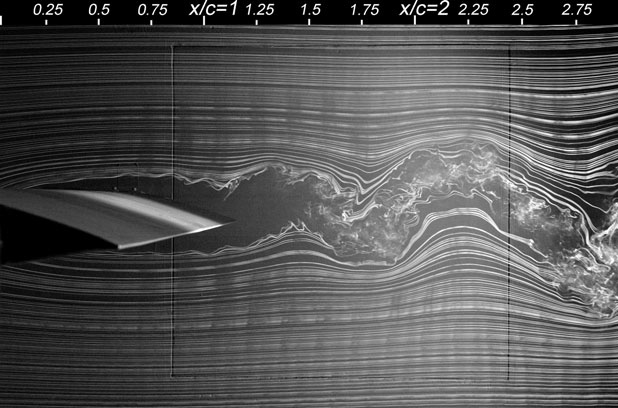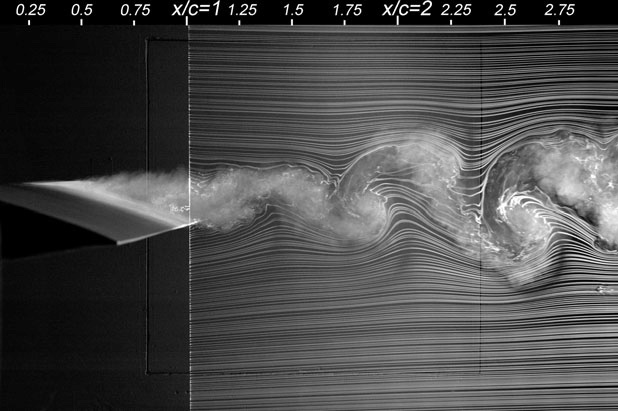Picture Attribution: Serhiy Yarusevych, Pierre Sullivan
Smoke-wire flow visualization at Reynolds numbers of 55,000 (image 1) and 100,000 (image 2), with the airfoil set at 5° angle of attack. At lower Reynolds number, the boundary layer begins to separate and roll into irregular vortices, while at higher Reynolds number a distinct vortex street forms in the wake. These images reveal the striking transition from smooth laminar streamlines to turbulent, unsteady vortex shedding.
I’m fascinated by how order gives way to chaos when I look at these pictures. Before abruptly unraveling into spirals and waves that feel alive, the flow starts out so serene, with lines that are steady and smooth. Higher speeds create a hypnotic street of motion where the air appears to dance in time, shedding vortices. More than science, in my opinion, these images reveal the hidden choreography of nature, demonstrating how something as intangible as air can create patterns as captivating as any piece of art.



9 Comments. Leave new
Third Prize, The way that the science was captured reveals a stunning visual phenomena that has played a part in much of technological innovation and design, and emphasizes something subtle, that we normally take for granted.
Second Prize – I really enjoy seeing the separation of the flow from the foil, and seeing how turbulence forms downstream. The flow visualization technique is a perfect way to view this phenomenon.
Third Prize. This is a really cool visualization of classical fluid phenomena. I like how well it shows the different flow lines. You could line this up with a fluids textbook and see how the models we use match up to real world flow.
First Prize – I think this photo gets first because it demonstrates firstly a practical application for this kind of imaging. Optimizing the shape of an airfoil to minimize turbulent flow is essential to aerodynamics.
Third Prize – I like how this image demonstrates that directly after the airfoil, the stream lines don’t instantly converge back into each other; the air flow doesn’t exactly follow the shape of the wing. The lighting and choice of grayscale really ups the contrast making the smoke lines almost pop out of the image.
Second Prize: To me, this is the primary example of what flow visualization is used for. I am in aerospace, done CFD research, and also a private pilot – so I LOVE a good NACA airfoil/reynold’s number/AoA visual. This is a great photo to demonstrate how lift is generated from the wing and how planes fly. I could talk about the phenomena in this picture for hourssss.
Third prize! I enjoy the visual progression of the streamlines transitioning into turbulent vortices. The contrast between the turbulent flow and less disturbed streamlines creates a very striking image.
Third Prize. The smoke-wire flow visualization technique is truly impressive. It offers a clear and straight forward demonstration of key aerodynamic processes such as laminar flow, boundary-layer behavior, separation, and turbulence. It turns these complex phenomena into forms that can be seen directly. It also shows a strong visual contrast between order and disorder, which shows strong artistic value.
First Prize – I like that this photo appears to both be used for scientific purposes but is also quite visually striking. I like how the smooth lines give way to a turbulent wavy pattern. The image being grayscale as well as the lighting really adds to the dramatic feel.